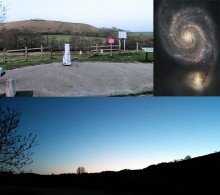It’s been a brilliant couple of weeks from a stargazing point of view. Early April saw a return to dark evening skies with the New Moon, and I had a couple of fantastic evening sessions. On one I was joined by a friend, and we had three telescopes set up! As well as the fun of comparing the different views afforded by different scopes, highlights for me included the Ghost of Jupiter planetary nebula, a previously unseen Messier object (M68 – a very low globular cluster), and the rather romantically named ‘Intergalactic Wanderer’ – a very faint and distant globular cluster. The latter was originally so-named because it was thought that it wasn’t originally from the Milky Way, but rather captured as it strayed too close. This is now known not to be the case, but the name has stuck. Although it’s around 900,000 times more massive than our Sun, and one of the brightest of all globular clusters in the galaxy, its distance of 300,000 light years from Earth means it appears very faint.
My notes for the evening also record that the view of the Whirlpool galaxy in Ursa Major (M51) was the ‘best ever!’ This face-on interacting pair of galaxies is an easy find, and really is a wonderful sight on a clear and dark night, with the spiral arms clearly visible! Other galaxies I recorded that evening include the Cocoon, the Whale, the Spindle, the Leo Triplet, and the Sombrero! In fact, the list of objects extends for a full page in my notebook; far too many to list individually here.
The highlight of my next session a couple of nights later was the Bow-Tie Nebula (Caldwell 2, discovered by William Herschel in 1788) in the constellation of Cepheus. This tiny planetary nebula is a tricky find, and, to be honest, not exactly an overwhelming sight, but for me it was a real achievement nonetheless. I also managed to tick off another Messier object: M93, an open star cluster in the constellation Puppis … only six more to go! Coincidentally, William Herschel’s sister Caroline is the first recorded observer of M93!
The weather on the night of the 7th of April, the night of the New Moon, wasn’t great, with patchy cloud getting in the way. Nevertheless I went out with my 10×50 binoculars and scanned around looking at some old favourites (Messiers 13, 36, 37, 38, 42, 45, 51, 52 and 92, plus several galaxies and star clusters). Not bad for a quick half hour session!
The evening of the 12th of April, with a very bright waxing crescent Moon saw me set up in the early evening (actually it was still daylight), in the hope of spotting Mercury, the one remaining planet I hadn’t seen. Mercury is tricky: being so close to the Sun, observing opportunities are limited, and it’s usually very low in the sky. After the Sun had set I scanned the western horizon for anything that could possibly be the planet, and, finally, there it was! I had less than five minutes viewing it before it, too, set. In binoculars Mercury appears as a very bright pinprick of light, the planetary orb shape only appearing with much higher magnification. Although showing no surface detail, and shimmering a lot due to being so low to the horizon, it was still great to see it.
From observing in the early evening, I switched my thoughts to having a go in the early morning. On Sunday the 17th, I was set up by 4.15, with the Milky Way literally sparkling overhead, and Mars and Saturn in my sights. I’d never seen Mars so large, and it’s set to get bigger and brighter as it approaches opposition in late May. It was way too bright to reveal any detail (I’ve since bought a filter to help with that), but still an impressive sight: a large, shimmery, reddish/orange orb … Saturn too was incredible. It’s tilted up quite high at the moment, and the rings and the Cassini division between them are very clear. Saturn’s largest moon Titan was also very big and bright.
It was incredible how soon the Sun came up, though, with dawn beginning to break over Giant Hill only half an hour after I’d set up. Still, the dawn chorus was wonderful to hear, and the planets stayed on view until well after 5.
What an amazing couple of weeks!
What’s up?
Unfortunately, the opportunity to view Mercury in the evening has now passed, but Jupiter’s still dominating the evening skies, and Saturn and Mars the early mornings.
Check out the very bright star rising in the northeast. Vega is in the constellation of Lyra (below and to the left of Hercules, and to the right of Cygnus. For me, these three constellations will dominate the night sky over the summer, and there’s a wealth of objects to explore in them. Those with moderate telescopes should be able to spot a couple of interesting sights in this patch of sky. M57, the Ring nebula is a relatively easy find, just below the bright star Vega, while just to the left of Cygnus’ upper wing is Caldwell 15, the Blinking planetary. Although a tricky find, this planetary nebula is quite fun. When you look directly at it it seems to disappear, and only reappears when you look away!
April/May is probably the best time to view the Virgo cluster of galaxies, and with the moon being full on the 20th of April, the coming couple of weeks are an ideal time to do so.
Clear skies!
Kevin Quinn is an amateur astronomer based in Cerne Abbas. He is the proud owner of a ten-inch reflector, a small refractor, a case of eyepieces, and a couple of pairs of binoculars. He tweets via @CerneAstro, and blogs via theastroguy.wordpress.com.
©Kevin Quinn







